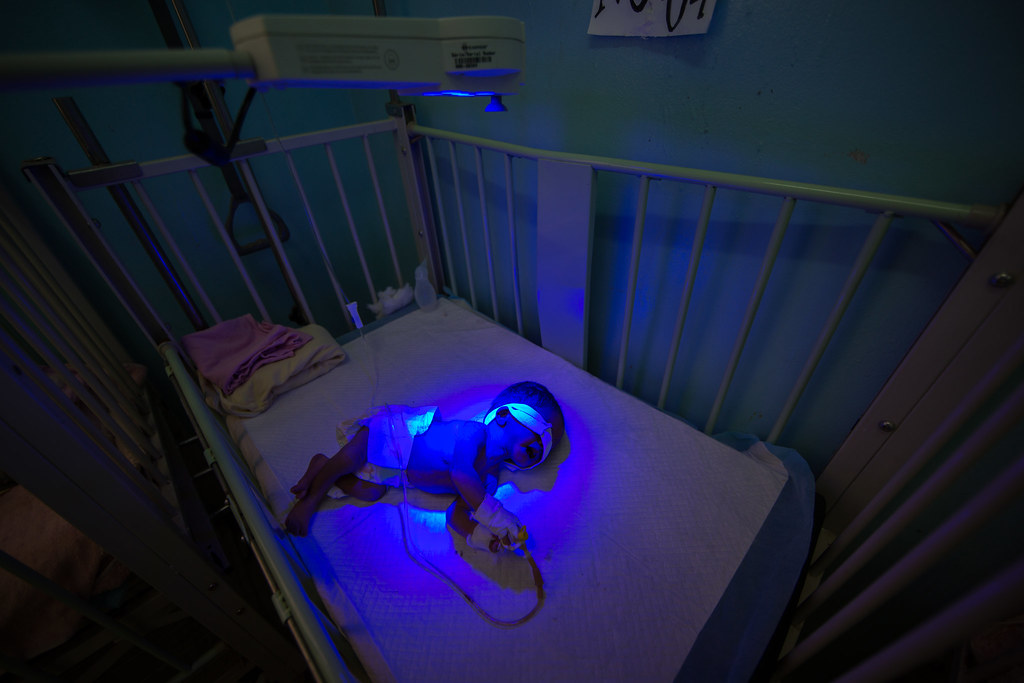Phototherapy for Jaundice
Phototherapy for jaundice is a widely used treatment for newborns with high bilirubin levels. Jaundice happens due to excess bilirubin, causing yellow skin and eyes in babies. The blue light exposes the newborn and helps break down bilirubin. Phototherapy is a safe, non-invasive, and effective treatment for jaundice. It reduces the risk of kernicterus, a serious brain damage caused by untreated jaundice.
Understanding Phototherapy: A Treatment for Jaundice in Newborns
- Phototherapy treats jaundice in newborns, a condition marked by yellow skin and eyes.
- Jaundice occurs due to elevated bilirubin, a byproduct of red blood cell breakdown.
- Newborn livers can’t fully process bilirubin, leading to jaundice.
- Phototherapy uses light to break down bilirubin for easier excretion through urine and stool.
- Blue light helps break down bilirubin in the newborn.
- Treatment duration varies based on jaundice severity, lasting several hours daily.
- Phototherapy safely reduces bilirubin levels, preventing serious complications like brain damage.
Blue Light Therapy for Jaundice: How Does It Work?
- Blue light therapy helps break down bilirubin in the blood.
- Bilirubin is produced by the liver during the breakdown of old red blood cells.
- In jaundice, the liver can’t effectively process bilirubin, causing its buildup in the bloodstream.
- Exposing the baby’s skin to blue light converts bilirubin into a form easily eliminated.
- The light penetrates the skin, breaking bilirubin into smaller molecules for kidney excretion.
- This helps reduce bilirubin levels and relieves jaundice symptoms.
- Blue light therapy is a safe and effective treatment for newborn jaundice.
- It is typically done in hospitals, with the baby placed under blue-spectrum light.
- Monitoring bilirubin levels ensures the therapy’s effectiveness and prevents complications.
Managing Bilirubin Levels in Infants through Phototherapy
Doctors commonly use phototherapy to manage elevated levels of bilirubin in infants, especially those with jaundice. This non-invasive treatment involves exposing the baby’s skin to a specific type of light that helps break down the bilirubin in the bloodstream. The baby’s skin usually absorbs the blue or green light, converting the bilirubin into a form that the body can easily excrete through the urine.
Doctors closely monitor the baby’s bilirubin levels during phototherapy to ensure that they are responding well to treatment. The duration and intensity of phototherapy may be adjusted based on the baby’s specific needs. Some infants may require phototherapy for only a few hours, while others may need it for several days. In severe cases, a baby may need to be admitted to the hospital for continuous phototherapy to prevent complications from high bilirubin levels.
While phototherapy is generally considered safe and effective, it is important for parents to follow all recommendations from medical professionals and to monitor their baby’s progress closely. In most cases, phototherapy successfully lowers bilirubin levels and resolves jaundice without any long-term consequences. However, if bilirubin levels remain high or other complications arise, additional treatments or interventions may be necessary.
The Procedure of Phototherapy for Jaundice in Newborns
Phototherapy is a common treatment for jaundice in newborns. The procedure involves exposing the baby’s skin to a special type of light that helps break down bilirubin, the substance causing the yellowing of the skin. This helps the baby’s liver to process and eliminate the excess bilirubin more efficiently.
During phototherapy, the newborn is usually placed under a specially designed lamp or light panel that emits blue or white light. The baby is typically naked except for a diaper and protective eyewear to shield their eyes from the bright light. The duration of phototherapy can vary depending on the severity of the jaundice, but it is often administered for a few days until the bilirubin levels decrease to a safe range.
While undergoing phototherapy, healthcare providers need to monitor the baby’s bilirubin levels regularly to ensure that the treatment is effective. In some cases, additional tests may be needed to determine the cause of jaundice and to rule out any underlying medical conditions. Overall, phototherapy is a safe and effective treatment for jaundice in newborns, helping them to recover and thrive.
At-Home Blue Light Therapy for Jaundice: What You Need to Know
At-home blue light therapy for jaundice is a convenient and effective option for treating newborns with mild to moderate jaundice. It involves exposing the baby’s skin to blue light, which helps break down bilirubin, the pigment that causes jaundice. You can do this therapy at home using a portable, specially designed-light device.
Consult a healthcare provider before starting any home treatment for proper dosage and duration.
Follow all instructions from your healthcare provider and the device manufacturer carefully.
Monitor your baby’s skin for irritation or burns, adjusting therapy distance and duration accordingly.
Track your baby’s bilirubin levels regularly with blood tests to ensure effective treatment.
For concerns about at-home light therapy, contact your healthcare provider for support.
Phototherapy Newborn: A Vital Treatment
Phototherapy for newborns is a crucial treatment for managing neonatal jaundice, a common condition in infants. This therapy involves placing the baby under special lights that help break down high levels of bilirubin in their blood. The process of phototherapy of newborns is non-invasive and effective, making it a preferred method for addressing jaundice. The baby’s liver can easily process bilirubin after the light converts it into a different form. Timely phototherapy can prevent complications and ensure a smooth recovery for newborns.

